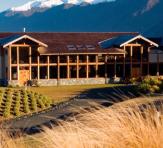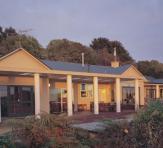Stewart Island is the southern most island of New Zealand. The Island is large, 64 km long, and 40 km across (at its widest point). It has a 700 km coastline, but there are only 20 km of roads! You won't walk round the Island in a day. Even ten days tramping only skirts the northern third. Few people can claim to have seen anywhere near the whole of Stewart Island. However, there is much to see, even close to the only settlement of Oban. For a day-trip or stay longer, as there is a good range of accommodation. Some visitors from twenty years ago are still living here. Terrain is rugged. The Island is made of granite, some of the oldest rock in New Zealand. A wide range of minerals are present, though not in commercial quantities. Tin was mined at Port Pegasus for a few years in the 1890's. There's black iron sand on some beaches, others are white with quartz or red with garnet. Most beaches are gold, sparkling in the sun. Don't bother bringing a gold-pan though - it's mainly "fool's gold"! Paterson Inlet almost cuts the Island in half. This large expanse of water is popular for boat-trips and recreational fishing and diving. Climate is mild, and a trifle damp. No worry, without rain, there wouldn't be rain-forest. The eastern lowlands are forest, right to the water's edge. A canopy of kamahi is pierced by majestic rimu and miro. Lianes and lush fern growth adorn the bush interior. The forest is a haven for bird-life, as there are fewer predators than on the mainland. Kaka, parakeets, tui, and bellbird give a wonderful dawn chorus in spring. New Zealand's national bird, the kiwi is found all round the Island. Seabirds abound off-shore. Albatross, petrels, cormorants, gulls and blue penguins are common. Rarer species like yellow-eye penguins are also seen often. Mason Bay, on the Island's West Coast is much different. It's a 12 mile crescent of sandy beach, with huge sand-hills and tussock and scrub in place of forest. This is the place to watch the white horses charge ashore in a screaming westerly gale. The original Maori name, Te Punga o Te Waka a Maui positions Stewart Island firmly at the heart of Maori mythology. Translated as “The Anchor Stone of Maui’s Canoe”, it refers to the part played by this Island in the legend of Maui and his crew, who from their canoe, the South Island, caught and raised the great fish, the North Island. Rakiura is, however, the more commonly known and used Maori name. It is usually translated as "Glowing Skies", possibly a reference to the sunsets for which Stewart island is famous or for the aurora australis the Southern lights that are a phenomenon of our Southern latitudes. For some, Rakiura is the abbreviated version of Te Rakiura a Te Rakitamau, translated as "great blush of Rakitamau", in reference to the latter's embarrassment when refused the hand in marriage of not one, but two daughters of an Island chief. In 1809 the Pegasus, sailing from Port Jackson, Australia, on a sealing expedition, had aboard as first officer William Stewart. Whilst the boat was in the large south eastern harbour which now bears its name, Stewart began charting the southern coasts and his work is acknowledged to this day in the Island’s present name.







